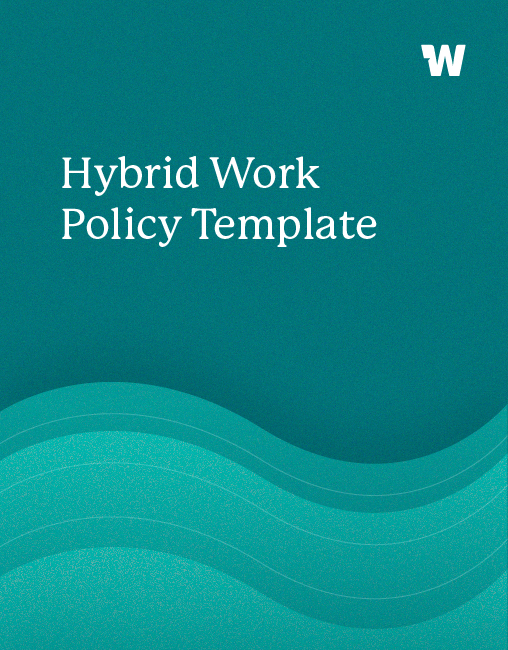Create
Quickly build beautiful emails & multi-channel campaigns with our easy-to-use design tools and templates.
Post-COVID, you may be looking to enact a more flexible remote and/or hybrid work policy. We’ve crafted a policy template to help you get the documentation started, and it’s completely customizable! Feel free to use ours as a sample, too.


This template is built on a premise of trusting your employees by default (until they break that trust). We have encountered a lot of remote and hybrid work policy templates that consider working remotely to be a privilege, and place rigorous checks on the employee to make sure they’re “actually working.” Of course, COVID-19 has changed how we all view remote work, and it’s now very apparent that a lot of work can get done, and a lot of employees are interested in continuing to work from home in the future.
That being said, it’s incredibly important to make sure that employees understand communication expectations and security requirements, and we take those very seriously throughout our example. We’ve also phrased many of the standard regulations in a way that benefits the employee, and not just the company itself.

BACKGROUND
We’ve added a section where you can put your hybrid work policy in context a bit, and explain whether or not this policy specifically applies to coronavirus, or is your general policy going forward. This is also a good place to emphasize that, like all great employee policies, it is subject to change and that you encourage feedback. Remember, what works at 50 employees might be very different than what works at 250!
WHO IS ELIGIBLE TO WORK REMOTELY?
Consider what positions are eligible to work remotely, and be upfront about those expectations. If you have certain roles (the example we use is office administrators) that can’t perform the key duties of their role remotely, this is where you should detail that out.
Your eligibility requirements may be fairly strict. Document those in a transparent way, and think about all of the roles within your company and whether or not they can function well in a remote environment. (For example, you may want to encourage a first-time manager to work in the office.) We find the best way to tackle the question is right at the beginning of the hiring process, which also ensures you get a fantastic pool of candidates that meet your initial expectations for location.
Of course, things change, and an in-office employee may want to or have to move. In the companies we’ve run in the past, we’ve always wanted our employees to come to us and request working remotely, before assuming we would say no and accepting another job offer. We’ve always preferred having the conversation and the chance to retain a high performer if possible.
Since the start of the pandemic, many employees have also chosen to move into new locations and, often, different states. There are significant tax considerations if you have out-of-state employees and additional work for the employer: you have to register with that employee’s state tax agency, learn the state’s pay and labor laws, withhold income taxes, and file all the required paperwork and payments. Any time zone change could affect support coverage or general availability, as well. As such, we’ve often seen employers start to list out here what states an employee can relocate to, and ask explicitly that they get in touch with HR if they are considering a move, even if they have always had a fully remote position.
This section is also a good place to lay out any in-person expectations for remote workers; we find that most companies, even those that are all-remote, want their employees to come together a couple of times a year.
WORKING HOURS, ATTENDANCE, & AVAILABILITY
This is where you list out all of the day-to-day expectations for working hours. Typically, the standards for working hours and attendance don’t change: a full-time employee is expected to work at least 40 hours a week, an hourly employee must track their time, and sick days/vacation days should be handled the exact same way.
There is an opportunity here to stress the importance of availability. For us, we trust all of our employees to get their work done. Whether or not an employee is “online” isn’t a matter of oversight or a lack of trust; it’s about being excellent to their teammates and available if needed. A team should know whether or not they can reach their peer or manager in an emergency, and if that work is covered.
For some workplaces, they will document expectations for response times and clocking in/clocking out with certain software. We don’t dictate that, but you may want to.
COMMUNICATION
Because you’re not next to one another in an office, any remote or hybrid employee should err on the side of overcommunication. Slack, email, Zoom, phone calls, and numerous other communication channels are available to you.
Your team and manager will likely have their own expectations for communication and response times; be sure you know what those are. If those expectations seem unreasonable, please discuss them with HR.
ENVIRONMENT
This is a section where it’s important to lay out the ideal work-from-home environment, but you may want to show that you’re also tolerant and understanding of the employee’s current circumstances. That being said, you may want to communicate expectations about childcare, professional backgrounds, etc.
PERFORMANCE EXPECTATIONS
The performance expectations for a remote or hybrid employee are no different than for an in-office employee. (We kept this one super simple!)
EQUIPMENT
You may have a formal process for hybrid employees to request equipment, or a standard set of items that you provide; this is a good place to detail those, whether that’s a laptop, second monitor, keyboard, mouse, etc. It’s also worth noting that because the employee works at home, other equipment within their home office setting is not the company’s responsibility.
SECURITY AND CONFIDENTIALITY
Many organizations are (rightfully) concerned about the security and confidentiality of their company’s sensitive information.
OTHER
A good section to jot down any other must-haves for your company’s hybrid work policy. Remind employees that the Employee Handbook and all other policies still apply to hybrid workers!
Not seeing the resource you need? Request the resource you need below and we’ll make one! Seriously!

Start your week inspired and energized with our practical newsletter about positive company culture! It features actionable articles and little surprises, sent every Monday morning.

Join our waitlist to be the first to learn when it's available!
Get a live demo & your questions answered with one of our product experts.

We'll also make sure you leave with: